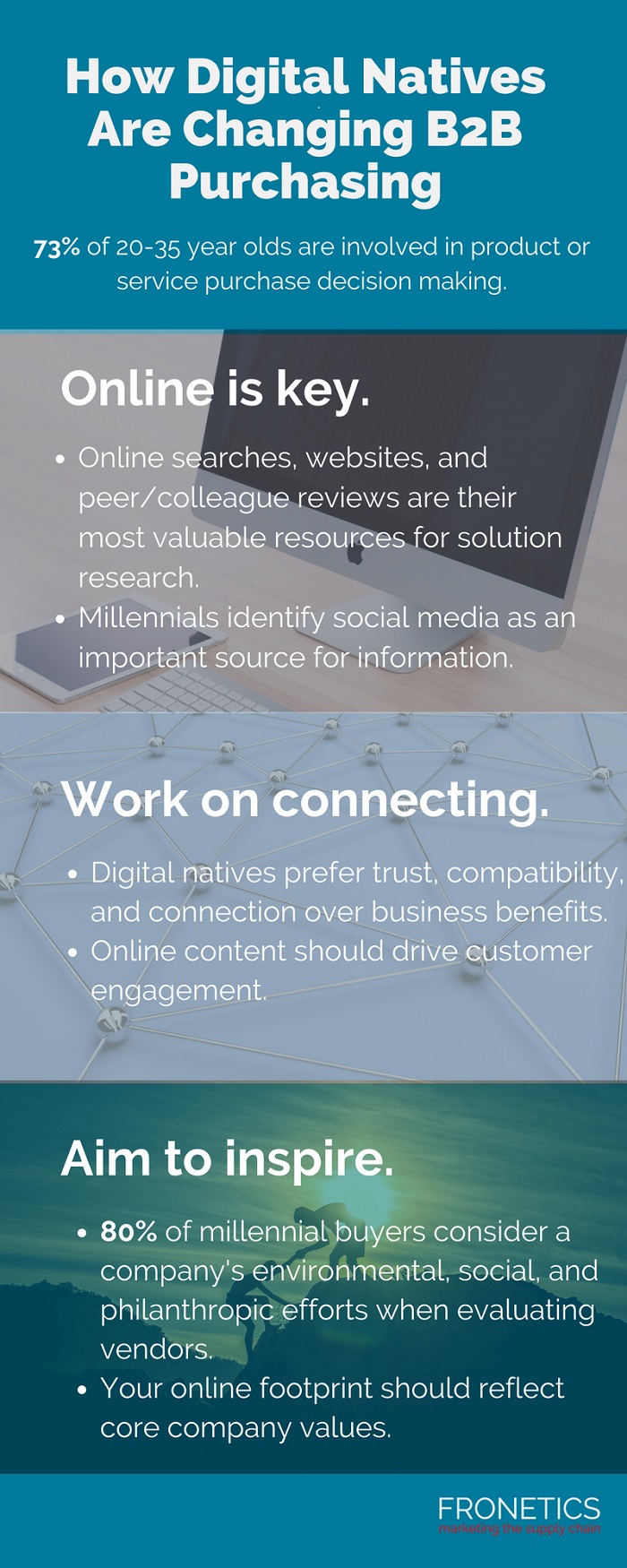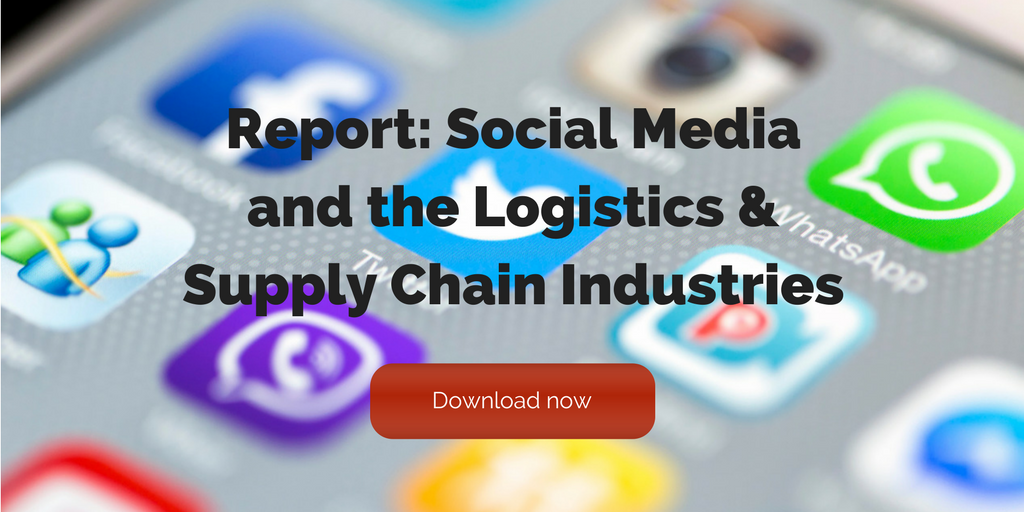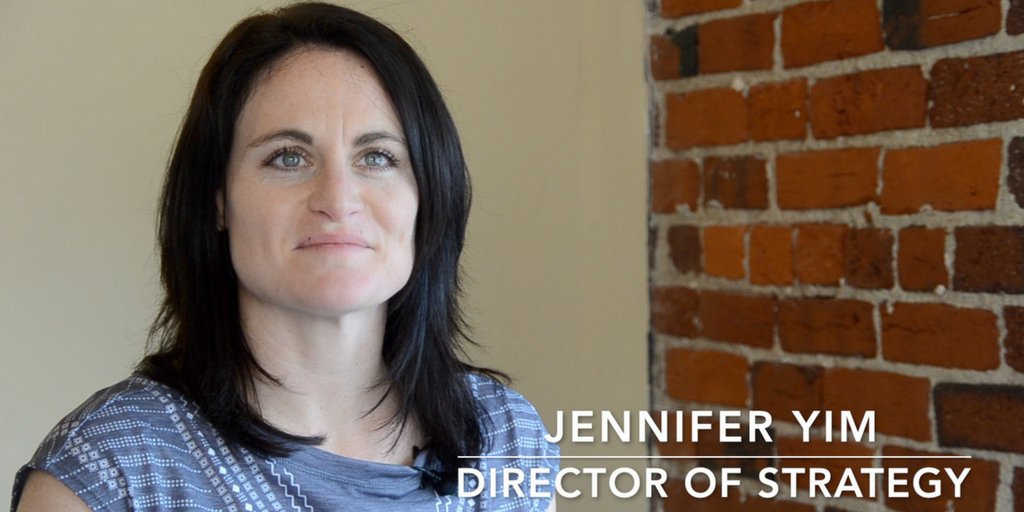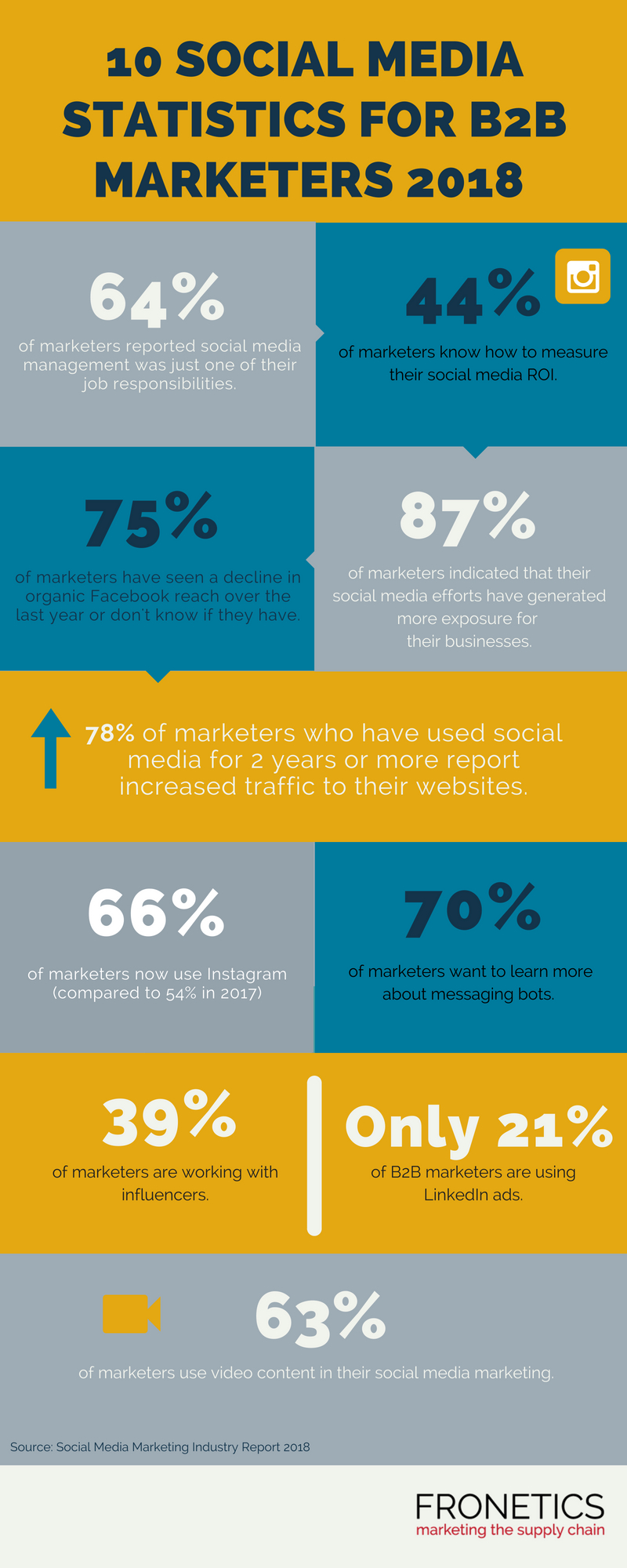
by Fronetics | Sep 12, 2018 | Blog, Content Marketing, Logistics, Marketing, Strategy, Supply Chain
Here are the top three resources digital natives are using to research solutions and how your B2B business can prepare to meet them online.
Knowing where your buyers do research when making purchasing decisions is crucial to any marketing strategy. Digital natives, a new generation of younger buyers, have completely revolutionized the purchasing landscape for B2B vendors. Their biggest resource? The world wide web.
[bctt tweet=”73% of employees ages 20-35 years old are involved in product or service purchase decision-making at their company. In fact, one-third reported they are the sole decision maker for their department.” username=”Fronetics”]
A study of millennial buyers by Merit found that 73% of employees ages 20-35 years old are involved in product or service purchase decision-making at their company. In fact, one-third reported they are the sole decision maker for their department.
What does this mean for B2B marketers?
These younger, and typically more technologically advanced, buyers expect they can find the information they need about your brand online through an organic search. Your company needs to have any and all content available at the push of a button.
But the work doesn’t stop there. Once a buyer finds your brand, you hope they make the leap to visit your website, meaning your site needs to be one of your most appealing assets. If you don’t give visitors plenty of easy, attractive opportunities to convert on your website, content marketing won’t generate leads for you.
But online searches and vendor website aren’t the only resources digital natives are using to make purchasing decisions. This younger generation also relies heavily on recommendations from peers and colleagues.
Like recommendations from friends and family in their personal lives, the opinion of other buyers becomes very important. A big part of the purchasing process involves B2B review sites, where purchasers seek the opinion of their peers and colleagues.
Here’s Elizabeth Hines, creative/editorial director at Fronetics, to discuss the top resources for B2B buyers and how you can be prepared to meet them online.
Video: top 3 resources for B2B buyers
Final thoughts
Though the purchasing landscape has changed over the past decade, B2B marketers have the tools to get in front of the right buyers. These tools including knowing what resources buyers are using and how to use these assets to your advantage. With a documented strategy and high-quality, informative content, you’ll be ready to meet digital natives where they are.
Related posts:


by Fronetics | Sep 6, 2018 | Blog, Content Marketing, Current Events, Logistics, Marketing, Social Media, Strategy, Supply Chain
Digital natives are changing the landscape for B2B purchasing. Here’s what you need to know about the new B2B buyer.
Long gone are the days of men and women sitting around a conference table listening to a sales pitch over a free lunch. Today’s B2B buyers are younger, more technologically savvy, and more independent — they’re a generation of digital natives. And they’re making waves across the B2B buying landscape and changing how marketers must work to reach new customers.
[bctt tweet=”Today’s B2B buyers are younger, more technologically savvy, and more independent — they’re a generation of digital natives. And they’re making waves across the B2B buying landscape and changing how marketers must work to reach new customers.” username=”Fronetics”]
Who are digital natives?
The term digital native describes a person that grows up in the digital age, rather than acquiring familiarity with digital systems as an adult. So, unlike the previous generation, digital natives grew up understanding how to work a computer and a mobile phone instead of picking up these skills (slowly) in our 20s, 30s, or even later.
Having grown up in a time of rapid technological advancement, digital natives are very comfortable online. These skills have carried over to their professional careers, as millennials descend upon the workforce. Organic searches have become the starting point for researching products and services, instead of looking for specific brands.
Ch-ch-changes
This new reality means marketers trying to reach new customers must make big changes in the way they target and engage today’s buyers. Marketers have had to shift their focus from outbound marketing to inbound tactics, like content marketing, to engage and connect with their target audiences.
Here’s what you need to know about digital natives and how their tech-savvy ways have changed the B2B purchasing process.
Infographic: How digital natives are changing B2B purchasing

(Made with Canva)
Final thoughts
With so much content available on the internet, first impressions are everything. Your website needs to be informative and visually pleasing. Your social media posts need to be engaging. Your blog posts need to be enlightening. Make sure your online presence accurately depicts who you are as a brand and what you stand for. Digital natives will be more likely to find and connect with you.
Have digital natives had an impact on your business? Tell us about it.
Related posts:


by Fronetics | Aug 23, 2018 | Blog, Content Marketing, Logistics, Marketing, Social Media, Supply Chain, Talent
Too many supply chain businesses are devoting inadequate resources and personnel to social media management.
Let’s be honest. It’s time for the supply chain to start taking social media management seriously. Even when we think we’re embracing the future, too may supply chain companies are stuck in the past when it comes to the way they think about marketing — and particularly the role of social media.
[bctt tweet=”A robust and effective social media strategy needs to be just that — a carefully designed and well-thought-out strategy, rather than simply something that an already overworked marketer adds to his or her plate.” username=”Fronetics”]
Case in point: the latest Social Media Marketing Industry Report indicates that for nearly two-thirds of marketers, managing social media marketing for their business is just one of their jobs.
Let’s think about that for a moment. That means that only one-third of the 5,700 businesses surveyed are prioritizing social media management to an adequate degree. For the other two-thirds, the vast and time-consuming task of social media management is squeezed into someone’s job description essentially as an afterthought.
If your business falls into that 64%, this is your wakeup call. Used to its fullest, social media is an immensely valuable set of tools for supply chain marketing. These platforms help brands increase visibility, establish themselves as thought leaders, attract new leads and customers, and much more.
If you’re not convinced (and you should be), take a look through Fronetics’ recent survey report on the benefits of social media for supply chain and logistics industries.
Social media management is no easy task
The thing about social media that so many businesses get wrong is that it’s not an easy task. Maybe you’re a marketer who’s been tasked with managing your brand’s social media efforts — on top of the rest of your responsibilities. It might have sounded like fun at first, essentially getting to scroll and post on Facebook for a few minutes out of the day. But chances are, you’re realizing that it’s a much bigger task than you thought.
A robust and effective social media strategy needs to be just that — a carefully designed and well-thought-out strategy, rather than simply something that an already overworked marketer adds to his or her plate.
For your business to truly take advantage of the benefits that social media can offer, you either need to devote adequate resources to it, or consider outsourcing it.
Is outsourcing right for you?
Supply chain companies are increasingly reaping the benefits of outsourcing their marketing efforts, particularly social media, as it allows them to focus on core competencies and improve productivity. As you consider trusting a professional with your social media, consider these 6 signs that outsourcing might be right for you.
The bottom line: if you’re frustrated that your social media management efforts are not as fruitful as you would like, chances are, you’re not giving them a chance. For social media to work for you, you need to devote the resources it demands — whether in house or out.
Related posts:


by Fronetics | Aug 20, 2018 | Blog, Content Marketing, Logistics, Marketing, Strategy, Supply Chain
Here’s a breakdown of the latest findings regarding the best time to send an email and what we recommend for getting the most of out of your email marketing efforts.
We are all inundated with daily emails. Whether it’s work emails, special offers from brands you love, or straight-up spam email, we all have inboxes full of emails – most of which will never be opened.
But, on the flip side, “email is the third most influential source of information for B2B audiences, behind colleague recommendations and industry thought leaders,” reports WordStream.
So how do you get your emails to stand out in cluttered inboxes? How do you get readers to actually open — and scroll through — your thoughtfully crafted content?
At Fronetics, we believe there isn’t a one-size-fits-all answer to what works best for email marketing. In order to be successful, you need to take into consideration:
- Who is your target audience?
- What job titles do they hold?
- What kind of devices do they use?
- When are they commuting to work?
Taking a look at the schedules and habits of your target audience will give you insight into the optimal times for readers to engage with your emails. Here’s Jennifer Hart Yim, director of strategy at Fronetics, with a look at what we recommend when trying to find your optimal time to send marketing emails.
[bctt tweet=”Taking a look at the schedules and habits of your target audience will give you insight into the optimal times for readers to engage with your emails. ” username=”Fronetics”]
Video: When is the best time to send an email?
Takeaway: Trial and error
As with most aspects of content marketing, there’s no universal answer to the best time to send marketing emails. The only way to truly know what works best for your company is trail and error. You’ll have to test dates and times to find the best time to send an email your target audience.
But keep in mind that there are other factors, aside from date and time, that affect open and click-through rates. You’ll also have to play around with frequency, subject lines, length of emails, and the overall look and feel of your email.
Have you tested your best time to send an email? What worked for your company?
Related posts:


by Fronetics | Aug 16, 2018 | Blog, Content Marketing, Data/Analytics, Logistics, Marketing, Social Media, Supply Chain
The latest social media statistics show growth of Instagram, more metrics for ROI, social messaging bots, and video content.
One thing that always holds true with social media platforms: they are constantly changing. Platforms like Facebook, Instagram, and Twitter have used 2018 to continue this trend of continual growth and improvement.
[bctt tweet=”One thing that always holds true with social media platforms: they are constantly changing. Platforms like Facebook, Instagram, and Twitter have used 2018 to continue this trend of continual growth and improvement.” username=”Fronetics”]
It’s important with all the changes to take a pause and analyze where these changes are taking us. Simple data can point us to the latest trends and show us where social media is heading.
Social Media Examiner’s 10th annual study, 2018 Social Media Marketing Industry Report, surveyed more than 5,700 marketers from across the world in a variety of industries to see how social media is changing. It offers a really comprehensive view of what’s going on in social media in our industry and beyond.
“This industry report also shows you how marketers’ organic activities have changed and what their future plans are with organic and paid social media,” write the report’s authors.
Here are 10 social media statistics from the report that reflect where social media is headed and what B2B marketers need to be paying attention to.
Infographic: 10 social media statistics for B2B marketers 2018

(Made with Canva)
Still want more?
I really recommend reading the 44-page report in its entirety from Social Media Examiner. There are pages and pages of interesting social media statistics that offer valuable insight into how marketers from all industries are using social media.
The report also shows how social media has changed in the last few years and even more rapidly in the past few months. With messaging bots and video content on the horizon, it’s hard not to wonder where social media will take us next.
What social media statistics are most interesting to you?
Related posts:











